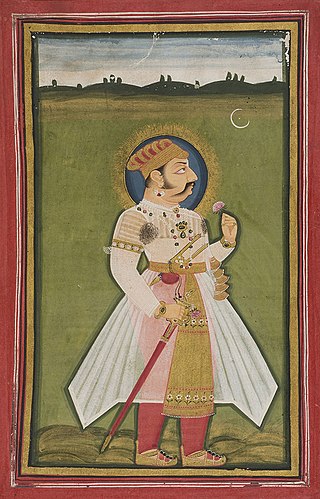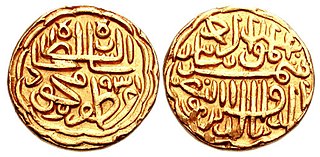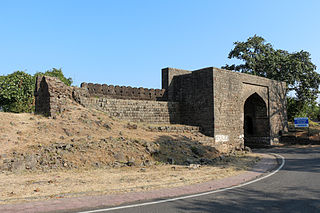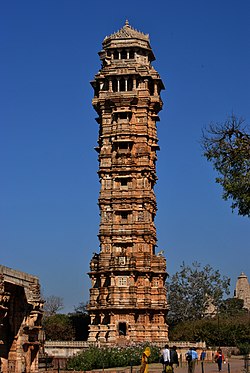
Rana Sangram Singh I, popularly known as Rana Sanga was the Maharana of Mewar from 1508 to 1528 CE. Belonging to the Sisodia Rajput dynasty, through his capable leadership, he transformed the Kingdom of Mewar into the most powerful state in northern India in the early 16th century. He controlled parts of present-day Rajasthan, Gujarat and Madhya Pradesh with his capital at Chittor. His reign was admired by several of his contemporaries, including the first Mughal Emperor Babur, who described him as the "greatest Indian ruler" of that time. The Mughal historian Abd al-Qadir Badayuni called Sanga the bravest of all Rajputs..

Chittorgarh is a major city in the state of Rajasthan in western India. It lies on the Berach River, a tributary of the Banas, and is the administrative headquarters of Chittorgarh District. It was a major stronghold of the Rajput State of Medapata. The city of Chittorgarh is located on the banks of river Gambhiri and Berach.
Maharana Hammir Singh (1302–1364), or Hammir, was a 14th-century ruler of Mewar in present-day Rajasthan, India. Hammir Singh, was a scion of the cadet branch Rana of the Guhila dynasty, who regained control of the region, re-established the dynasty after defeating the Tughlaq dynasty, and captured present-day Rajasthan from Muslim forces of Delhi and became the first of the 'Rana' branch to become the King of Mewar with title of Maharana. Hammir also became the progenitor of the Sisodia clan, a branch of the Guhila dynasty, to which every succeeding Maharana of Mewar has belonged.

Rana Kumbha or Kumbhkaran Singh (1433–1468), popularly known as Maharana Kumbha, was the ruler of the Kingdom of Mewar. He belonged to the Sisodia clan of Rajputs. It was during his reign that Mewar became one of the most powerful political powers in northern India. He is considered to be the most powerful ruler of his time in India.

Ratnasimha was a ruler of the Medapata (Mewar) kingdom in present-day Rajasthan, India. He belonged to the Rawal branch of the Guhila dynasty, which ruled from the Chitrakuta fort. The last ruler of this branch, he was defeated by Alauddin Khalji during the Siege of Chittorgarh in 1303 CE.

The Chittorgarh, also known as Chittod Fort, is one of the largest living forts in India. It is a UNESCO World Heritage Site. The fort was the capital of Mewar and is located in the present-day city of Chittorgarh. It sprawls over a hill 180 m (590.6 ft) in height spread over an area of 280 ha above the plains of the valley drained by the Berach River. The fort covers 65 historic structures, which include four palaces, 19 large temples, 20 large water bodies, 4 memorials and a few victory towers.

Shams-ud-Din Muzaffar Shah II or Muzafar II, born Khalil Khan, was a Sultan of the Muzaffarid dynasty, who reigned over the Gujarat Sultanate from 1511 to 1526. He was the eldest son of Sultan Mahmud Begada and his Rajput wife, Rani Hírabai.

The Kingdom of Mewar, sometimes known as Udaipur State, was an independent kingdom in Rajputana region of India, ruled by the Sisodia dynasty. It was established around the 6th century by the minor rulers of the Nagada-Ahar region of Udaipur and later, in the 10th century, it transformed into an independent state under Rawal Bharttripatta II.

The siege of Chittorgarh was the military expedition of the Mughal Empire under Akbar against the Mewar kingdom that commenced in 1567 during which the Mughals successfully captured the fort of Chittorgarh after a hard-pressed siege which lasted for several months.

Hill Forts of Rajasthan are six forts, spread across Rajasthan state in northern India. They have been clustered as a series and designated as a UNESCO World Heritage Site in 2013. The hill forts series include—Chittor Fort at Chittorgarh, Kumbhalgarh Fort at Rajsamand, Ranthambore Fort at Sawai Madhopur, Gagron Fort at Jhalawar, Amer Fort at Jaipur and Jaisalmer Fort at Jaisalmer.
The history of human settlement in the west Indian state of Rajasthan dates back to about 5,000 years ago.

Mahmud Khalji (1436–1469), also known as Mahmud Khilji and Ala-ud-Din Mahmud Shah I, was the Sultan of Malwa, in what is now the state of Madhya Pradesh, India. Khilji came into power after assassinating Mohammad, the son of the previous ruler, Hoshang Shah, in 1435. He mounted an unsuccessful campaign against the Delhi Sultanate however, it was under his reign that the Malwa Sultanate reached its greatest height.

The Battle of Gagron was fought in 1519 between Mahmud Khalji II of Malwa and Rajput Confederacy of Rana Sanga. The conflict took place in Gagron and resulted in Sanga's victory, with him taking Mahmud captive and annexing significant territory.
The Battle of Mandalgarh and Banas were two major battles fought between Rana Kumbha of Mewar and Mahmud Khalji of Malwa which resulted in two indecisive conflicts.

The Battle of Sarangpur was fought between Rana Kumbha and Sultan Mahmud Khilji. Mahpa Panwar, who was one of the assassins of Rana Mokal, was sheltered by the Sultan of Mandu. A demand for this person was made by Rana Kumbha, but Mahmud Khilji refused to surrender the refugee. The Rana prepared for hostilities and advanced to attack Mandu. The Sultan advanced with a powerful army to meet Kumbha.
Qutb-ud-Din Ahmad Shah II, born Jalal Khan, was a ruler of the Muzaffarid dynasty, who reigned over the Gujarat Sultanate from 1451 to 1458. He defeated invading Malwa forces at the battle of Kapadvanj. He tried to capture Nagor and came in conflict with Rana Kumbha of Chittor.

The siege of Chittorgarh occurred in 1303, when the Khalji ruler Alauddin Khalji captured and sacked the Chittor Fort, toppling the Guhila king Ratnasimha, after an eight-month-long siege. The conflict has been described in several legendary accounts, including the historical epic poem Padmavat, which claims that Alauddin's motive was to obtain Ratnasimha's beautiful wife Padmini; though this legend is considered historically inaccurate by most historians. Alauddin ordered the fort to be pelted with stones from his siege engines (munjaniqs). When the fort was stormed, Rajput women committed Jauhar while most of the warriors died defending the fort. The city of Chittor was completely sacked by Alauddin's army and several temples were desecrated.

The Mewar- Malwa conflict was a series of wars between the Kingdom of Mewar and the Islamic Sultanate of Malwa. The conflict erupted due to mutual territorial expansion triggered by both sides on each other. The war was fought in what is now known as the Indian states of Rajasthan and Madhya Pradesh. The Rana branch of the Guhilas, following their successful recovery of the Rajput stronghold of Chittorgarh and the entire region of Mewar alongside Rajputana after the Battle of Singoli, embarked on an ambitious expansion at the cost of their neighboring kingdoms. On the other side, with the invasion of Timur, the Lame Delhi Sultanate grew weak with its multiple subahs gaining independence which included Malwa, adjacent to Mewar.

The Conquest of Mandalgarh was a military expedition led by Sultan Mahmud Khalji of Malwa against Mewar. The primary objective of this campaign was to capture the Mandalgarh fort, which was under the command of Uparamal, a subordinate of Rana Kumbha. Mahmud Khalji marched towards Mewar in the year 1457 to achieve this goal.














